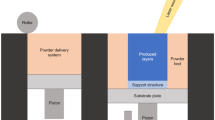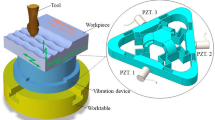Abstract
Although axial ultrasonic vibration-assisted milling (AUVAM) is promising for rapid and economical fabrication of 3D micro-texture on various surfaces, it has been a challenge to obtain micro-texture with small feature size and large height simultaneously. The mechanism and major influence factors for the formation of micro-texture by this method were explored in this study. It was found that the generation of micro-texture was mainly caused by cutting and extrusion from the flank face of the milling tool under ultrasonic vibration. Therefore, a novel 3D tool model that considered the relief angle, end cutting edge angle and the blade profile was established in simulation analysis. The good agreement between simulation and experimental results demonstrated that the influence of the flank face on the micro-texture was mainly attributed to the relief angle of the milling tool. It was the first time to report that both the height and the profile shape of the micro-texture unit were affected by the overlap and extrusion between the flank surface and the micro-texture. But this influence diminished with the increase of spindle speed. 3D sinusoid-shaped micro-texture with minimum width of 20 μm and height of 2 μm (fully reproduced the ultrasonic amplitude) was realized with the relief angle of 40° and spindle speed of 4000 rpm. Other typical textures of weave, shell, scale and corrugation were also presented to show the effective regulation of texture patterns in AUVAM. This work provides both theoretical and practical basis for such a low-cost, efficient and controllable 3D micro-texture preparation method.


















Similar content being viewed by others
References
Jiang Y, Shen H, Pu T, Zheng C, Tang Q, Gao K, Wu J, Rui C, Li Y, Liu Y (2017) High efficiency multi-crystalline silicon solar cell with inverted pyramid nanostructure. Sol Energy 142:91–96. https://doi.org/10.1016/j.solener.2016.12.007
Li L, Yi AY (2010) Development of a 3D artificial compound eye. Opt Express 18:18125–18137. https://doi.org/10.1364/oe.18.018125
Sun J, Luo X, Chang W, Ritchie JM, Chien J, Lee A (2012) Fabrication of periodic nanostructures by single-point diamond turning with focused ion beam built tool tips. J Micromech Microeng. https://doi.org/10.1088/0960-1317/22/11/115014
Jahed Z, Molladavoodi S, Seo BB, Gorbet M, Tsui TY, Mofrad MR (2014) Cell responses to metallic nanostructure arrays with complex geometries. Biomaterials 35:9363–9371. https://doi.org/10.1016/j.biomaterials.2014.07.022
Jeon H, Simon CG JR, Kim G (2014) A mini-review: Cell response to microscale, nanoscale, and hierarchical patterning of surface structure. J Biomed Mater Res B Appl Biomater 102:1580–1594 https://doi.org/10.1002/jbm.b.33158
Zhang J, Tian W, Chen J, Yu J, Zhang J, Chen J (2019) The application of polyetheretherketone (PEEK) implants in cranioplasty. Brain Res Bull 153:143–149. https://doi.org/10.1016/j.brainresbull.2019.08.010
Zhao W, Wang L, Xue Q (2010) Design and fabrication of nanopillar patterned au textures for improving nanotribological performance. ACS Appl Mater Interfaces 2:788–794. https://doi.org/10.1021/am900788t
Zhang S, Zhou Y, Zhang H, Xiong Z, To S (2019) Advances in ultra-precision machining of micro-structured functional surfaces and their typical applications. Int J Mach Tools Manuf 142:16–41. https://doi.org/10.1016/j.ijmachtools.2019.04.009
Hosseinabadi HN, Sajjady SA, Amini S (2018) Creating micro textured surfaces for the improvement of surface wettability through ultrasonic vibration assisted turning. Int J Adv Manuf Technol 96:2825–2839. https://doi.org/10.1007/s00170-018-1580-2
Chowdhury H, Loganathan B, Wang Y, Mustary I, Alam F (2016) A Study of Dimple Characteristics on Golf Ball Drag. Procedia Eng 147:87–91. https://doi.org/10.1016/j.proeng.2016.06.194
Chen X, Zhai W, Dong S, Zheng K, Xu R, Wang J, Liu X, Lu W (2020) Investigations on torsional fretting wear properties of CuAlNi processed by ultrasonic vibration-assisted milling. Tribol Int. https://doi.org/10.1016/j.triboint.2020.106238
Hussain SQ, Ahn S, Park H, Kwon G, Raja J, Lee Y, Balaji N, Kim H, Le AHT, Yi J (2013) Light trapping scheme of ICP-RIE glass texturing by SF6/Ar plasma for high haze ratio. Vacuum 94:87–91. https://doi.org/10.1016/j.vacuum.2013.01.026
Liu X, Li Y (2011) Analysis of LIGA-Ni Microstructure. AEMT, Sanya, PEOPLES R CHINA 284–286:1574–1578. https://doi.org/10.4028/www.scientific.net/AMR.284-286.1574
Borjali A, Monson K, Raeymaekers B (2018) Friction between a polyethylene pin and a microtextured CoCrMo disc, and its correlation to polyethylene wear, as a function of sliding velocity and contact pressure, in the context of metal-on-polyethylene prosthetic hip implants. Tribol Int 127:568–574. https://doi.org/10.1016/j.triboint.2018.07.005
Koyano T, Hosokawa A, Takahashi T, Ueda T (2019) One-process surface texturing of a large area by electrochemical machining with short voltage pulses. CIRP Ann 68:181–184. https://doi.org/10.1016/j.cirp.2019.04.100
Xu S, Kuriyagawa T, Shimada K, Mizutani M (2017) Recent advances in ultrasonic-assisted machining for the fabrication of micro/nano-textured surfaces. Front Mech Eng China 12:33–45. https://doi.org/10.1007/s11465-017-0422-5
Liu Q, Xu J, Yu H (2020) Experimental study of tool wear and its effects on cutting process of ultrasonic-assisted milling of Ti6Al4V. Int J Adv Manuf Technol 108:2917–2928. https://doi.org/10.1007/s00170-020-05593-3
Verma GC, Pandey PM, Dixit US (2018) Modeling of static machining force in axial ultrasonic-vibration assisted milling considering acoustic softening. Int J Mech Sci 136:1–16. https://doi.org/10.1016/j.ijmecsci.2017.11.048
Ni C, Zhu L (2020) Investigation on machining characteristics of TC4 alloy by simultaneous application of ultrasonic vibration assisted milling (UVAM) and economical-environmental MQL technology. J Mater Process Technol. https://doi.org/10.1016/j.jmatprotec.2019.116518
Chen G, Ren C, Zou Y, Qin X, Lu L, Li S (2019) Mechanism for material removal in ultrasonic vibration helical milling of Ti 6Al 4V alloy. Int J Mach Tools Manuf 138:1–13. https://doi.org/10.1016/j.ijmachtools.2018.11.001
Baraheni M, Amini S (2020) Mathematical model to predict cutting force in rotary ultrasonic assisted end grinding of Si3N4 considering both ductile and brittle deformation. Measurement. https://doi.org/10.1016/j.measurement.2020.107586
Amini S, Baraheni M, Khaki M (2021) Empirical study on ultrasonic assisted turn-milling. Proc. Inst. Mech. Eng. Part E: J Process Mech Eng 235:1469–1478. https://doi.org/10.1177/09544089211008714
Feng Y, Hsu FC, Lu YT, Lin YF, Lin CT, Lin CF, Lu YC, Liang SY (2019) Residual stress prediction in ultrasonic vibration–assisted milling. Int J Adv Manuf Technol 104:2579–2592. https://doi.org/10.1007/s00170-019-04109-y
Feng Y, Hsu FC, Lu YT, Lin YF, Lin CT, Lin CF, Lu YC, Liang SY (2020) Temperature prediction of ultrasonic vibration-assisted milling. Ultrasonics 108:106212. https://doi.org/10.1016/j.ultras.2020.106212
Feng Y, Hsu FC, Lu YT, Lin YF, Lin CT, Lin CF, Lu YC, Liang SY (2020) Force prediction in ultrasonic vibration-assisted milling. Mach Sci Technol 25:307–330. https://doi.org/10.1080/10910344.2020.1815048
Feng Y, Hsu FC, Lu YT, Lin YF, Lin CT, Lin CF, Lu YC, Liang SY (2020) Tool wear rate prediction in ultrasonic vibration-assisted milling. Mach Sci Technol 24:758–780. https://doi.org/10.1080/10910344.2020.1752240
Feng Y, Hsu FC, Lu YT, Lin YF, Lin CT, Lin CF, Lu YC, Lu X, Liang SY (2020) Surface roughness prediction in ultrasonic vibration-assisted milling. J Adv Mech Des Syst Manuf 14:JAMDSM0063-JAMDSM0063. https://doi.org/10.1299/jamdsm.2020jamdsm0063
Shen XH, Tao GC (2015) Tribological behaviors of two micro textured surfaces generated by vibrating milling under boundary lubricated sliding. Int J Adv Manuf Technol 79:1995–2002. https://doi.org/10.1007/s00170-015-6965-x
Chen W, Zheng L, Huo D, Chen Y (2018) Surface texture formation by non-resonant vibration assisted micro milling. J Micromech Microeng. https://doi.org/10.1088/1361-6439/aaa06f
Chen W, Zheng L, Xie W, Yang K, Huo D (2019) Modelling and experimental investigation on textured surface generation in vibration-assisted micro-milling. J Mater Process Technol 266:339–350. https://doi.org/10.1016/j.jmatprotec.2018.11.011
Shen XH, Shi YL, Zhang JH, Zhang QJ, Tao GC, Bai LJ (2020) Effect of process parameters on micro-textured surface generation in feed direction vibration assisted milling. Int J Mech Sci. https://doi.org/10.1016/j.ijmecsci.2019.105267
Lu H, Zhu L, Yang Z, Lu H, Yan B, Hao Y, Qin S (2021) Research on the generation mechanism and interference of surface texture in ultrasonic vibration assisted milling. Int J Mech Sci. https://doi.org/10.1016/j.ijmecsci.2021.106681
Börner R, Winkler S, Junge T, Titsch C, Schubert A, Drossel WG (2018) Generation of functional surfaces by using a simulation tool for surface prediction and micro structuring of cold-working steel with ultrasonic vibration assisted face milling. J Mater Process Technol 255:749–759. https://doi.org/10.1016/j.jmatprotec.2018.01.027
Zhao B, Li P, Zhao C, Wang X (2020) Fractal characterization of surface microtexture of Ti6Al4V subjected to ultrasonic vibration assisted milling. Ultrasonics. https://doi.org/10.1016/j.ultras.2019.106052
Guo P, Ehmann KF (2013) An analysis of the surface generation mechanics of the elliptical vibration texturing process. Int J Mach Tools Manuf 64:85–95. https://doi.org/10.1016/j.ijmachtools.2012.08.003
Liu X, Wu D, Zhang J, Hu X, Cui P (2019) Analysis of surface texturing in radial ultrasonic vibration-assisted turning. J Mater Process Technol 267:186–195. https://doi.org/10.1016/j.jmatprotec.2018.12.021
Kilic ZM, Altintas Y (2016) Generalized modelling of cutting tool geometries for unified process simulation. Int J Mach Tools Manuf 104:14–25. https://doi.org/10.1016/j.ijmachtools.2016.01.007
Tao G, Ma C, Bai L, Shen X, Zhang J (2016) Feed-direction ultrasonic vibration−assisted milling surface texture formation. Mater Manuf Processes 32:193–198. https://doi.org/10.1080/10426914.2016.1198029
Gao H, Yue C, Liu X, Nan Y (2019) Simulation of surface topography considering cut-in impact and tool flank wear. Appl Sci. https://doi.org/10.3390/app9040732
Zhu L, Ni C, Yang Z, Liu C (2019) Investigations of micro-textured surface generation mechanism and tribological properties in ultrasonic vibration-assisted milling of Ti–6Al–4V. Precis Eng 57:229–243. https://doi.org/10.1016/j.precisioneng.2019.04.010
Acknowledgements
The authors sincerely appreciate financial supports from Fundamental Research Funds for the Central Universities (19CX02020A) and the National Natural Science Foundation of China (51905546), Key Technology Research and Development Program of Shandong (2018GGX103034).
Author information
Authors and Affiliations
Contributions
First author contributions established theoretical model, conceived and designed experiments, analyzed the data and wrote the initial manuscript. Corresponding author contributions received editor correspondence and send in revisions. Second author contributions established theoretical model, performed the experiments; analyzed the data; contributed on the writing of the manuscript. Other co-authors contributions: all co-authors have almost contributed equally. The major work involved is as follows: performed the experiments; contributed to reagents and materials; sent the sample to the test; analyzed the data; and reviewed each paper draft.
Corresponding author
Ethics declarations
Competing Interests
The authors declare that they have no known competing financial interests or personal relationships that could have appeared to influence the work reported in this paper.
Additional information
Publisher's Note
Springer Nature remains neutral with regard to jurisdictional claims in published maps and institutional affiliations.
Supplementary Information
Below is the link to the electronic supplementary material.
Rights and permissions
Springer Nature or its licensor holds exclusive rights to this article under a publishing agreement with the author(s) or other rightsholder(s); author self-archiving of the accepted manuscript version of this article is solely governed by the terms of such publishing agreement and applicable law.
About this article
Cite this article
Zhang, Z., Liu, W., Chen, X. et al. Generation mechanism of surface micro-texture in axial ultrasonic vibration-assisted milling (AUVAM). Int J Adv Manuf Technol 122, 1651–1667 (2022). https://doi.org/10.1007/s00170-022-09974-8
Received:
Accepted:
Published:
Issue Date:
DOI: https://doi.org/10.1007/s00170-022-09974-8




